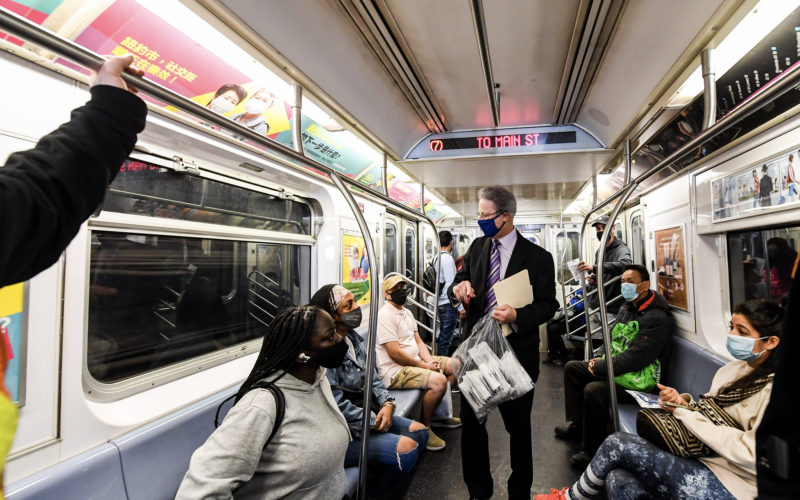
Long Island – which stretches to the east of New York City – is often seen as a place that set the template for American suburban sprawl. It is the home of Levittown, the paradigmatic American suburb of the 1940s, as well as several of Robert Moses’s highways, including the Southern and Northern State Parkways and the Long Island Expressway. Long Island’s boom after the Second World War was enabled by those highways, and largely driven by residential growth and highway-centered office parks. But in recent years, Long Island’s economy has faced severe challenges as the 20th-century model of one-dimensional suburbia has not adapted to the market of today and instead become a recipe for sclerosis.

The “Dashing Dan” logo of the LIRR, introduced in 1959, exemplified the railroad’s suburban commuter orientation — which has not fundamentally changed since.
The Rauch Foundation’s Long Island Index has tracked these challenges for 10 years, finding that by many economic measures Long Island now lags its counterparts in Westchester and northern New Jersey. Young people are moving away and not looking back, in part because Long Island lacks compelling downtowns and alternatives to the single-family home. Meanwhile, affordable housing has become a major concern along with less-than-robust job growth. Earlier this month, the foundation released an analysis of the economic potential of the Long Island Railroad Third Track, a proposal to add a 9.8-mile third track to the railroad’s two-track Main Line.
The Third Track would increase reliability and speed of the existing system, but more importantly it would reconceptualize what the system can do. The proposal would start to alter the railroad’s emphasis on the 20th-century model of bringing suburban commuters into New York City in the morning and back out in the afternoon. Other parts of the NYC metro area have evolved beyond that model, using bidirectional ridership opportunities on the rail network to stimulate secondary job centers like White Plains, N.Y., Jersey City and Hoboken, N.J., and Stamford and Norwalk, Conn. – places that are out-performing jurisdictions on Long Island. These places have had significant job growth, and now attract workers from NYC, serve as hubs for their regions, and increasingly offer the amenities and lifestyles that attract high-wage professionals and young families. Transit improvements, like a third track on Metro-North’s Harlem Line and the Hudson-Bergen Light Rail in New Jersey, helped enable the reverse commute in those areas, while Long Island remained in a one-way world.
The LIRR Third Track could be similarly catalytic. As it stands today, working on Long Island is not accessible for many NYC residents. Between 6 and 10 am, the LIRR runs just two trains an hour in the eastbound direction to Hicksville, with no trains at all between 7 and 8:15 am. Changing this would give Long Island businesses access to hundreds of thousands of additional workers.
The report foresees huge benefits from the Third Track, thanks to that expanded workforce, denser employment nodes, and transit time savings that would make Long Island municipalities more attractive places to live and work. By 2035, it envisions 14,000 new jobs, $5.6 billion increase in the region’s economy, and 35,400 new residents — 77% of whom would be younger than 45. Notably, these benefits would be only half that if towns on Long Island fail to enact transit-oriented zoning policies, a reminder that “soft” policy changes are needed to maximize the expensive investments we make in hard infrastructure. Put another way, localities could double the benefits of the Third Track without spending a penny more, but simply by amending their zoning codes.

Image via Long Island Index.
But in the past, the public conversation on Long Island has boiled down to a NIMBY issue. The Third Track would involve taking property in some towns, and some versions of the project envision taking additional land to eliminate grade crossings. Some local mayors have concluded the project will do nothing to benefit their towns, refusing to acknowledge any larger benefit. State politicians would ideally take a broader view, but have often toed the same line.
At the Rauch Foundation’s press conference on the report, business and labor officials spoke in support of the Third Track. Their support will be critical, as the crux of the issue is not money but whether elected leaders are willing to get serious about a fading region’s future. A common anti-growth refrain on Long Island, heard at public forums and from leading politicians, is that “we don’t want to turn into Queens.” But the danger is not that Long Island will turn into Queens; it’s that the Island threatens to become a hollowed-out version of itself — a backwater community of aging residents, expensive living, and low-skilled service jobs. As suburbs in New Jersey, southwestern Connecticut, and the Hudson Valley embrace rail-connected regional job centers, Long Island’s leaders cling to past models of development at their peril.
 On the Brink: Will WMATA’s Progress Be Erased by 2024?
On the Brink: Will WMATA’s Progress Be Erased by 2024?
The experience of being a WMATA rider has substantially improved over the last 18 months, thanks to changes the agency has made like adding off-peak service and simplifying fares. Things are about to get even better with the launch of all-door boarding later this fall, overnight bus service on some lines starting in December, and an ambitious plan to redesign the Metrobus network. But all of this could go away by July 1, 2024.
Read More What’s Going on With Transit Service at the Seven Highest Ridership U.S. Cities? NYC Edition
What’s Going on With Transit Service at the Seven Highest Ridership U.S. Cities? NYC Edition
New York City Transit’s service levels have remained remarkably strong throughout the pandemic. Crew operator availability remains the agency’s biggest challenge, as well as adjusting weekend maintenance schedules in order to run service that matches strong weekend demand.
Read More